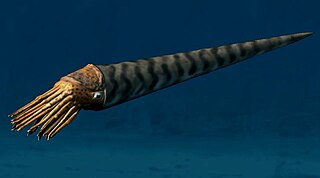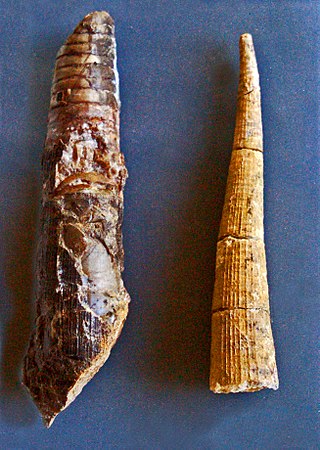
Nautiloids are a group of marine cephalopods (Mollusca) which originated in the Late Cambrian and are represented today by the living Nautilus and Allonautilus. Fossil nautiloids are diverse and speciose, with over 2,500 recorded species. They flourished during the early Paleozoic era, when they constituted the main predatory animals. Early in their evolution, nautiloids developed an extraordinary diversity of shell shapes, including coiled morphologies and giant straight-shelled forms (orthocones). Only a handful of rare coiled species, the nautiluses, survive to the present day.

Orthoceras is a genus of extinct nautiloid cephalopod restricted to Middle Ordovician-aged marine limestones of the Baltic States and Sweden. This genus is sometimes called Orthoceratites. Note it is sometimes misspelled as Orthocera, Orthocerus or Orthoceros.

Orthocerida is an order of extinct Orthoceratoid cephalopods also known as the Michelinocerida that lived from the Early Ordovician possibly to the Late Triassic. A fossil found in the Caucasus suggests they may even have survived until the Early Cretaceous. They were most common however from the Ordovician to the Devonian.
Discosorida are an order of cephalopods that lived from the beginning of the Middle Ordovician, through the Silurian, and into the Devonian. Discosorids are unique in the structure and formation of the siphuncle, the tube that runs through and connects the camerae (chambers) in cephalopods, which unlike those in other orders is zoned longitudinally along the segments rather than laterally. Siphuncle structure indicated that the Discosorida evolved directly from the Plectronoceratida rather than through the more developed Ellesmerocerida, as did the other orders. Finally and most diagnostic, discosorids developed a reinforcing, grommet-like structure in the septal opening of the siphuncle known as the bullette, formed by a thickening of the connecting ring as it draped around the folded back septal neck.

Plectronocerida is a primitive order from which subsequent cephalopod orders are ultimately derived.
The Ellesmerocerida is an order of primitive cephalopods belonging to the subclass Nautiloidea with a widespread distribution that lived during the Late Cambrian and Ordovician.
Clarkoceras is a genus of breviconic ellesmerocerid cephalopods, one of only two genera known to have crossed from the Late Cambrian, Trempealeauan, into the Early Ordovician, Gasconadian. ; the other being Ectenolites.

The Ellesmeroceratidae constitute a family within the cephalopod order Ellesmerocerida. They lived from the Upper Cambrian to the Lower Ordovician. They are characterized by straight and endogastric shells, often laterally compressed, so the dorso-ventral dimension is slightly greater than the lateral, with close spaced sutures having shallow lateral lobes and a generally large tubular ventro-marginal siphuncle with concave segments and irregularly spaced diaphragms. Connecting rings are thick and layered, externally straight but thickening inwardly with the maximum near the middle of the segment so as to leave concave depressions on internal siphuncle molds. Septal necks are typically orthochoanitic but vary in length from almost absent (achoanitic) to reaching halfway to the previous septum (hemichoanitic) and may even slope inwardly (loxochoanitic).
Paraloxoceras is a genus of straight shelled, orthoconic nautiloid cephalopods, now extinct, that lived during the Early Carboniferous. Fossils have been found in Europe and central Asia; the type, P. konincki, named by Flower, came from Belgium.

Kionoceras is an extinct nautiloid cephalopod genus included in the orthocerid family Kionoceratidae with scattered worldwide distribution from the Middle Ordovician to the Lower Permian. Kionoceratids are orthocerids with prominent longitudinal ornamentation on their shells, sometimes augmented by secondary transverse ornamentation. Orthocerids are, of course, prehistoric nautiloides with generally straight and elongate shells, mostly with central or subcentral siphuncles.
Bactroceras is a genus of orthoceratoid cephalopods that lived during the early Middle Ordovician, from about 472—464 mya, existing for approximately 8 million years.
Baltoceratidae is an extinct family of orthoconic cephalopods belonging to the subclass Nautiloidea endemic to what would be Asia, Australia, Europe, North America, and South America during the Ordovician living from about 480–460 mya, existing for approximately 20 million years.
Basslerocerida is an order of nautiloid cephalopods from the Ordovician comprising exogastric longiconic cyrtocones, that is no longer in common use.
Protcycloceratidae is an extinct family of slender, commonly annulate, members of the cephalopod order Ellesmerocerida that lived during the Early Ordovician.

Paradakeoceras is a genus of early Ordovician cephalopods belonging to the nautiloid order Ellesmerocerida.
Conostichoceras is a genus of exogastric, breviconic oncocerids included in the family Nothoceratidae, known from the Middle Devonian of central Europe and Upper Devonian of Australia. It probably lived on and swum above the sea floor.
Plectronoceratoidea is a superorder or subclass containing primitive nautiloids from the Late Cambrian and Early Ordovician. This group is best considered a paraphyletic grade of early cephalopods, as it contains the ancestors of subsequent post-Cambrian cephalopod orders.
Murrayoceras is a nautilid cephalopod included in the orthocerid family Baltoceratidae, widespread in the Middle Ordovician of North America, characterized by a depressed orthoconic shell with a subtriangular cross section and flattened venter and a proportionally large ventral siphuncle, 0.15 to 0.3 the dorso-ventral shell diameter. Septa are close spaced with sutures forming broad lobes on the upper flanks and ventral surface.
Albertoceras is a genus of Early Ordovician ellesmeroceratids with a small, slender, orthoconic to slightly endogastric shell; some even tiny. The cross section is strongly compressed so as to make the height proportionally notably greater than the width. The sutures, marking the edges of the septa, have broad, shallow, lateral lobes. The siphuncle, which seems to lack diaphragms, lies close to the venter.
Lawrenceoceras is a genus of moderately curved, gently expanding bassleroceratids from the Lower Ordovician of eastern North America. Septa dividing the chambers are close spaced; sutures straight, transverse; the siphuncle narrow, submarginal.





